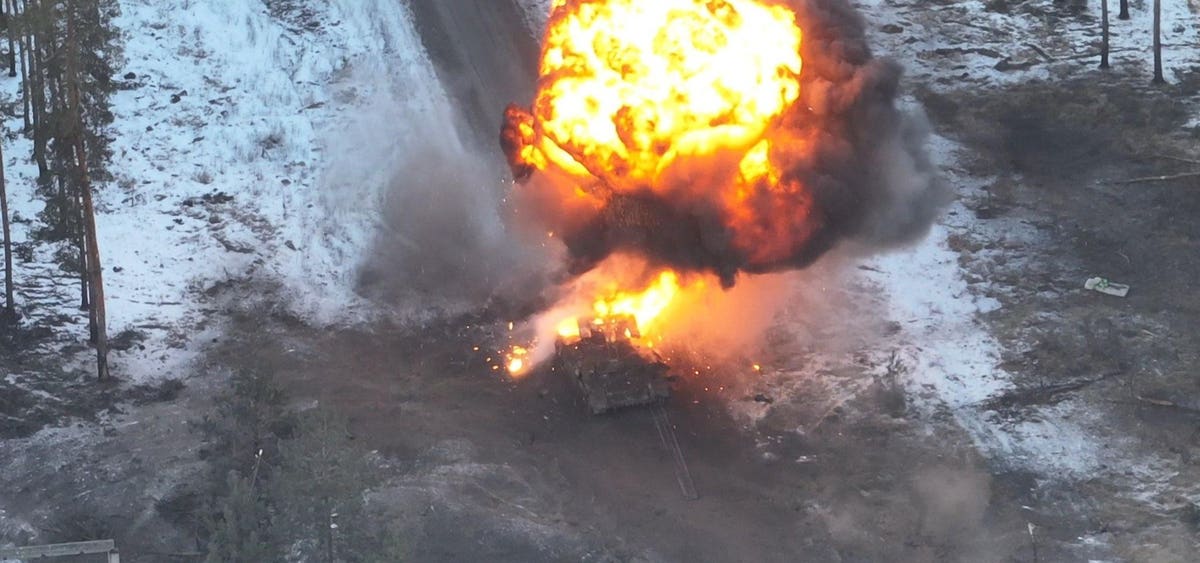Shortly after Ukrainian forces launched their long-anticipated counteroffensive starting on June 4, Russian forces launched a countercounteroffensive, with the clear aim of spoiling the larger Ukrainian attacks by forcing Kyiv to redirect resources to a defensive effort.
The Ukrainians have focused their offensive on key axes in Kherson, Zaporizhzhia and Donetsk Oblasts in southern Ukraine as well as around the ruins of Bakhmut in eastern Ukraine’s Donbas region. The Russians meanwhile have focused their own offensive on the forests west of occupied Kreminna in northeastern Ukraine.
While it’s fair to say the Ukrainians are struggling in the south, slowly advancing but at a high cost, it’s equally fair to say the Russians also are struggling in the northeast: hurling more and more of their forces into a faltering effort.
War Translated, a social media account that translates videos and documents from the Ukraine front line, highlighted a video of Russian soldiers the Ukrainians recently captured west of Kreminna. In the video, the bedraggled prisoners express their bewilderment over their mission. “We had no choice,” one soldier says.
“They just pointed at us, put us in a truck and brought us here,” a soldier adds.
These prisoners certainly don’t represent the best of the Russian armed forces, 18 months into Russia’s wider war on Ukraine. Despite Russia’s heavy losses—many tens of thousands of dead plus even more wounded—there still are well-trained and reasonably well-equipped tank, motor-rifle and special forces regiments and brigades in the Russian order of battle.
And successive waves of mobilization and conscription have added bulk to the best front-line formations. As of April, the Russian force in Ukraine was bigger than was the force that initially widened the war back in February 2022, according to NATO’s top commander.
That should put current Russian manpower on or near the frontline as high as 200,000 people. And if a recent estimate from the Kyiv Independent is accurate, the Kremlin has concentrated perhaps half that force in and around Kreminna for the countercounteroffensive.
The sheer size of the Russian force along this axis helps to explain how it was able to advance while the Russians almost everywhere else were merely holding the line—or falling back. The Russians in recent weeks have captured a few square miles west of Kreminna. That’s much less territory than the Ukrainians recently have liberated in the south.
In one sense, the Kremlin’s plan to spoil the Ukrainian counteroffensive actually is working. Kyiv has deployed at least two of its newest brigades—the 21st and 44th Mechanized Brigades, both with Western-made combat vehicles—to the Kreminna sector.
There’s no doubt the Ukrainian general staff would have preferred to send those fresh, well-equipped brigades farther south to join the counteroffensive.
But to compel the Ukrainians to divert their brigades away from the southern front and toward Kreminna, the Russians had to send to the Kreminna sector a huge number of their own regiments and brigades—units that can’t man the southern trenchlines while they’re busy attacking in the northeast.
The Kremlin is gambling that the cost to the Ukrainians of defending around Kreminna is greater than is the cost to the Russians of attacking around Kreminna. It’s not yet clear whether that gamble will pay off.
And it’s equally possible that the gamble will backfire on the Russians, and badly. That the Russians will lose so many troops and vehicles trying to spoil the Ukrainian offensive that they end up spoiling their own defensive.
And they might do so without necessarily gaining much ground around Kreminna as a consolation. Note that Ukrainian forces in recent days have begun counterattacking around Kreminna. That’s right, a countercountercounteroffensive.
One Russian blogger warned of a possible self-spoiling by Russian forces, according to War Translated. “Fortifications, no matter how powerful they are, are of little worth without the necessary filling,” they wrote.
“The enemy is not interested in the depth of his penetration into our defenses, but in changing the balance of forces in the sector,” they added. “If ours grind down faster than the enemy, then instead of an unshakable wall at the main line of defense, he may encounter emptiness or almost emptiness.”
That “emptiness” could be coming for the Russians—and if so, it could radically alter the war’s dynamics. Those fortifications that have slowed the Ukrainian counteroffensive suddenly would be no obstacle at all. Just an inconvenience.
Read the full article here





